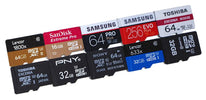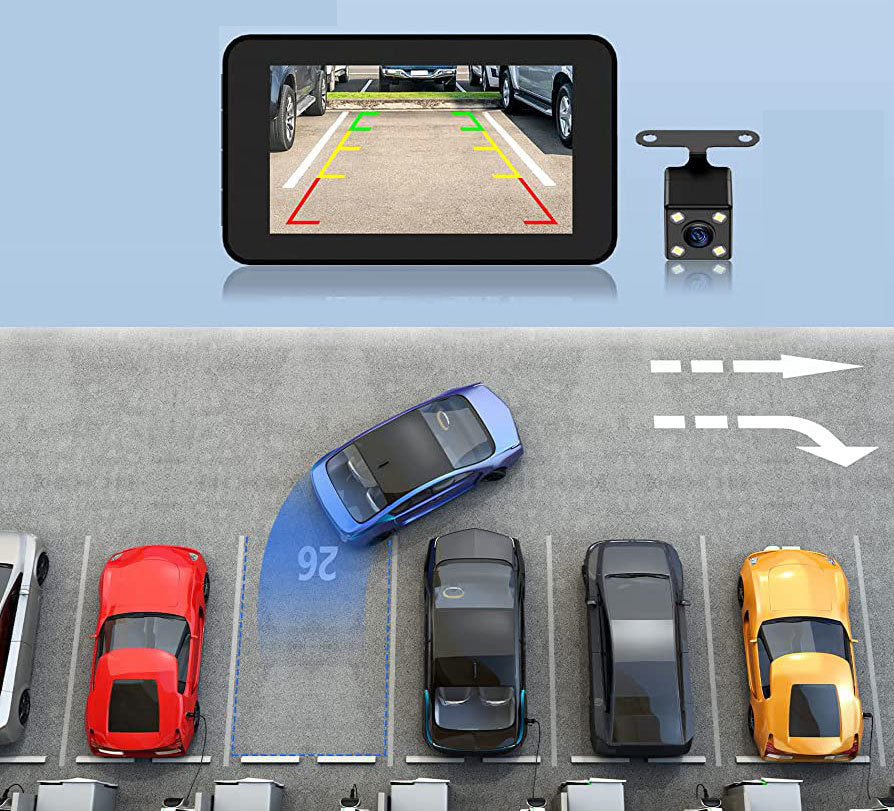
The right SD card for your dashcam
, by Allcam dashcams, 6 min reading time

, by Allcam dashcams, 6 min reading time
Explanation about how to use the right SD card in your dashcam.
Every dashcam needs a (micro)SD card to film. But what exactly is such an SD card and what should you look out for before buying one?
An SD (Secure Digital) card - also known as a memory card - is a small card containing so-called ‘Flash memory’. Flash memory is a type of file storage where data is not erased when the device is switched off. The name Flash came about because all data on the card can be erased at once and replaced with new data, making an SD card very fast. This characteristic makes the SD card very suitable for devices that need to store or erase larger amounts of data in a short time, such as in a dashcam, camera or smartphone.

When we talk about different types of SD cards, in this case we mean the size of the card. Three types of SD cards can be distinguished;
Standard SD cards are often still used in larger devices such as SLR cameras, the MiniSD card is hardly seen anywhere anymore. The MicroSD card is currently the standard and you see it in almost all electronics such as smartphones, cameras and dashcams. The big advantage is the small size, while a MicroSD card does not have to be inferior to larger SD cards in terms of storage capacity.
Note: Most laptops and PCs have an SD card slot, but this is usually the standard (large) SD card format. Therefore, most MicroSD cards come with an SD adapter that you can put the MicroSD card in so that you can still read it on your computer.
When SD cards were introduced, capacities of 128, 256 and 512 MB (MegaByte) and 1, 2 and 4 GB (GigaByte) were available. From 2012, only cards from 2 GB onwards are available.
SDHC
SD cards from 4 to 32 GB are also called SDHC (SD High Capacity). SDHC cards cannot be used in older generation devices, i.e. before SDHC was introduced. Devices that SDCH cards can be used in are usually marked with an ‘HC’ symbol, but actually almost all electronics in use today are compatible with SDHC.
SDXC
SDXC is the designation for SD cards with a capacity of 64gb and higher. Devices with an SDHC designation cannot be used with SDXC cards, but SDHC cards can (usually) be used in equipment that supports SDXC. This often requires formatting the card in the device first.
Not every SD card is equally fast, meaning that the time in which files can be stored and downloaded onto the SD card varies from model to model. Speed is often referred to in the same way as with older CD-ROMs, where ‘1x’ stands for 150kb/s (KiloByte per second). Nowadays, SD cards are available up to 1800x (2700MB/s) and this is increasing every year. However, no standard has been specified for the x-value of dashcams, so this does not guarantee that the card actually reaches this speed. There are therefore some other standards that give guarantees about the speed of an SD card.
Class / Class
The class system was one of the first standards for indicating the speed of SD cards. Through the class system, manufacturers give a kind of guarantee of the minimum available file transfer rate. The class of the SD card is indicated by the corresponding number in a C, as shown below;
Nowadays, SD cards are actually no longer made with a class lower than 10 and sometimes this is not even mentioned. There are therefore some newer standards that manufacturers can make use of.
UHS
UHS (Ultra High Speed) is a newer standard for faster SD cards that specifies a promised minimum speed. The UHS value is often listed next to the Class value on the SD card. A UHS SD card can only be used in devices that support UHS, but nowadays this applies to almost all electronics. A distinction is made between UHS-1 (minimum 10MB/s) and UHS-3 (minimum 30MB/s). The UHS standard is indicated by a ‘U’ containing the relevant value.
V-value
Since 2016, there has been a special video speed class that also indicates a minimum write speed. This new class is important because more and more devices are recording video at 4K or even 8K. The V class ranges from V6 to V90, with the number indicating the number of MB/s.
SD cards, despite having no moving parts like a hard disk, have a limited lifespan. This is because SD cards have a limited number of write cycles. These are the number of write operations performed on the card. Every time a file is put or deleted on the SD card, it affects the life of the SD card. The number of cycles depends heavily on the brand, most SD card can handle between 2,000 and 5,000 cycles.
For regular use this is enough to last for years, for use in dashcams this is unfortunately not the case. Because a dashcam stores a very large number of files (fragments), the number of write cycles is reached relatively quickly. It is therefore possible that after about a year, the dashcam starts to show signs of malfunction and no longer functions properly. This is usually because the SD card has then reached its maximum number of cycles.
MLC / High Endurance
Recently, many brands have started offering so-called ‘High Endurance’ cards. These cards are specially designed for use in video recording equipment. The High Endurance cards are developed with so-called MLC technology, which can tolerate a lot more write cycles. MLC cards can generally handle around 10,000 write cycles and therefore last a lot longer.
Preferably use a new SD card from a well-known A-brand (Samsung, Sandisk, Lexar, Transcend or Kingston) and from a reliable seller (no Aliexpress, for example). SD cards from other brands - e.g. Kruidvat or Action - are usually too slow and thus not suitable for use in dashcams.
Most A-brand SD cards made today are fast enough for use in dashcams. If your dashcam records in True 4K, it might be useful to choose a faster type of SD card, for example with V30 class or higher, just to be sure. In terms of durability, our experience is that ‘standard’ MicroSD cards are fine if you use the dashcam occasionally. If you spend several hours on the road every day, it might be useful to choose a High Endurance card.


